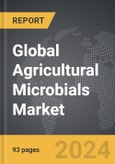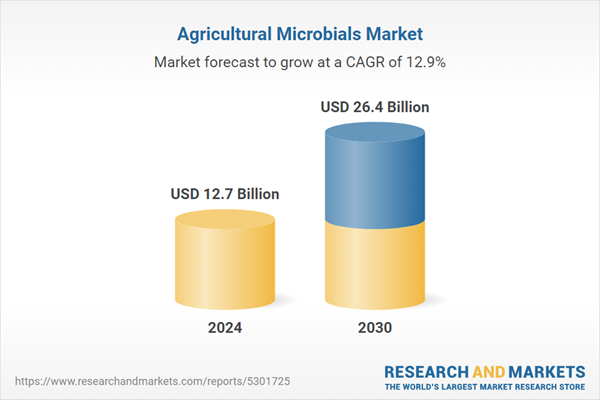The global market for Agricultural Microbials was valued at US$12.7 Billion in 2024 and is projected to reach US$26.4 Billion by 2030, growing at a CAGR of 12.9% from 2024 to 2030. This comprehensive report provides an in-depth analysis of market trends, drivers, and forecasts, helping you make informed business decisions.
Global Agricultural Microbials Market - Key Trends and Drivers Summarized
How Are Agricultural Microbials Revolutionizing Modern Farming?
Agricultural microbials, a category of biological products comprising beneficial microorganisms such as bacteria, fungi, viruses, and protozoa, are transforming the landscape of modern farming by providing eco-friendly solutions to enhance crop health, productivity, and sustainability. These microorganisms work symbiotically with plants to improve nutrient uptake, enhance resistance to pests and diseases, and stimulate overall plant growth. For instance, bacteria like Bacillus and Pseudomonas help break down organic matter, releasing nutrients such as nitrogen and phosphorus, which are essential for plant growth. Similarly, fungi such as Trichoderma and mycorrhizae form symbiotic relationships with plant roots, improving water absorption and nutrient uptake. These microbials not only offer a natural alternative to chemical fertilizers and pesticides but also contribute to soil health by restoring the microbial diversity that is often depleted by conventional agricultural practices. As the agricultural sector faces increasing pressure to produce more food sustainably, agricultural microbials are becoming an integral part of farming systems worldwide, particularly in organic and regenerative agriculture, where they help reduce the environmental footprint of food production.Why Are Agricultural Microbials Gaining Importance in Sustainable Farming?
The growing importance of agricultural microbials in sustainable farming stems from their ability to address several environmental and agricultural challenges. First and foremost, they provide an effective means of reducing reliance on synthetic fertilizers and chemical pesticides, which have been linked to issues such as soil degradation, water contamination, and the loss of biodiversity. By enhancing natural processes like nitrogen fixation and nutrient cycling, microbials allow farmers to reduce the input of synthetic chemicals while maintaining or even improving crop yields. For example, nitrogen-fixing bacteria convert atmospheric nitrogen into forms that plants can absorb, significantly reducing the need for chemical nitrogen fertilizers. Furthermore, certain microbial products act as biological control agents, protecting crops from a variety of pests and diseases by outcompeting harmful pathogens or producing compounds that inhibit their growth. This reduces the need for chemical pesticides, lowering the risk of pesticide resistance and contributing to more resilient agricultural systems. Moreover, microbials play a critical role in improving soil health by enhancing microbial diversity and organic matter content, which are essential for long-term soil fertility and water retention. As climate change and environmental degradation continue to threaten global food security, agricultural microbials are increasingly viewed as a key solution to ensuring the sustainability and resilience of agricultural systems.What Role Is Technology Playing in the Development of Agricultural Microbials?
Technology is a driving force behind the rapid development and adoption of agricultural microbials, enhancing their effectiveness and making them more accessible to farmers. Advances in microbial research, particularly in genomics and biotechnology, have enabled scientists to identify and engineer specific strains of microorganisms that can target particular crops or agricultural challenges with high precision. For instance, genomic sequencing has allowed researchers to select microbial strains that are highly efficient at nitrogen fixation or phosphorus solubilization, leading to the development of more specialized and effective microbial products. Formulation technologies have also seen significant improvements, with innovations in encapsulation and stabilization techniques ensuring that microbial products remain viable for longer periods, improving their shelf life and efficacy under diverse environmental conditions. Precision agriculture technologies are further advancing the use of microbials by enabling farmers to apply these products more accurately, ensuring that they are delivered exactly where and when they are needed. Tools like drones, GPS-guided tractors, and soil health sensors allow for the targeted application of microbials, maximizing their impact while minimizing waste. These technological advancements are making agricultural microbials not only more effective but also more appealing to a wide range of farming operations, from large-scale commercial farms to smallholder farmers seeking sustainable and cost-effective alternatives to conventional inputs.What Factors Are Fueling the Growth of the Agricultural Microbials Market?
The growth in the agricultural microbials market is driven by several key factors, including increasing demand for sustainable agricultural practices, advances in microbial research, and the shifting preferences of both farmers and consumers. One of the primary growth drivers is the global push for sustainability in agriculture, as governments and environmental organizations call for reduced use of synthetic fertilizers and pesticides due to their adverse environmental impacts. Agricultural microbials offer a viable alternative that can improve soil health and crop productivity while mitigating pollution and conserving biodiversity. The rising costs of synthetic agricultural inputs, exacerbated by supply chain disruptions and geopolitical issues, have also encouraged farmers to seek more affordable and sustainable options like microbials. Additionally, consumer demand for organic and pesticide-free food is pressuring agricultural producers to adopt greener farming practices, further boosting the adoption of microbial products, particularly in organic farming. The continued advances in microbial research and formulation technologies are making these products more efficient and reliable, increasing their appeal to a broader range of farmers. Finally, supportive government policies, particularly those promoting sustainable farming and carbon sequestration through soil health initiatives, are creating favorable regulatory environments for the agricultural microbials market. As a result, this sector is experiencing robust growth, with new innovations and applications continually expanding the potential of microbials to address the evolving needs of modern agriculture.Report Scope
The report analyzes the Agricultural Microbials market, presented in terms of market value (US$ Thousand). The analysis covers the key segments and geographic regions outlined below.Segments
Crop Type (Cereals & Grains, Oilseeds & Pulses, Fruits & Vegetables, Other Crop Types); Function (Soil Amendments, Crop Protection); Formulation (Liquid, Dry); Application (Foliar Spray, Soil Treatment, Seed Treatment, Other Applications).Geographic Regions/Countries
World; United States; Canada; Japan; China; Europe (France; Germany; Italy; United Kingdom; Spain; Russia; and Rest of Europe); Asia-Pacific (Australia; India; South Korea; and Rest of Asia-Pacific); Latin America (Argentina; Brazil; Mexico; and Rest of Latin America); Middle East (Iran; Israel; Saudi Arabia; United Arab Emirates; and Rest of Middle East); and Africa.Key Insights:
- Market Growth: Understand the significant growth trajectory of the Cereals & Grains Crop segment, which is expected to reach US$8.6 Billion by 2030 with a CAGR of a 13.3%. The Oilseeds & Pulses Crop segment is also set to grow at 12% CAGR over the analysis period.
- Regional Analysis: Gain insights into the U.S. market, valued at $3.2 Billion in 2024, and China, forecasted to grow at an impressive 17% CAGR to reach $6.5 Billion by 2030. Discover growth trends in other key regions, including Japan, Canada, Germany, and the Asia-Pacific.
Report Features:
- Comprehensive Market Data: Independent analysis of annual sales and market forecasts in US$ Million from 2024 to 2030.
- In-Depth Regional Analysis: Detailed insights into key markets, including the U.S., China, Japan, Canada, Europe, Asia-Pacific, Latin America, Middle East, and Africa.
- Company Profiles: Coverage of major players such as Agrilife Biosolutions Ltd., BASF SE, Bayer CropScience, Bioworks, Inc., Certis USA LLC and more.
- Complimentary Updates: Receive free report updates for one year to keep you informed of the latest market developments.
Why You Should Buy This Report:
- Detailed Market Analysis: Access a thorough analysis of the Global Agricultural Microbials Market, covering all major geographic regions and market segments.
- Competitive Insights: Get an overview of the competitive landscape, including the market presence of major players across different geographies.
- Future Trends and Drivers: Understand the key trends and drivers shaping the future of the Global Agricultural Microbials Market.
- Actionable Insights: Benefit from actionable insights that can help you identify new revenue opportunities and make strategic business decisions.
Key Questions Answered:
- How is the Global Agricultural Microbials Market expected to evolve by 2030?
- What are the main drivers and restraints affecting the market?
- Which market segments will grow the most over the forecast period?
- How will market shares for different regions and segments change by 2030?
- Who are the leading players in the market, and what are their prospects?
Some of the 37 major companies featured in this Agricultural Microbials market report include:
- Agrilife Biosolutions Ltd.
- BASF SE
- Bayer CropScience
- Bioworks, Inc.
- Certis USA LLC
- CHR. Hansen Holdings
- Corteva
- Koppert Biological Systems B.V
- Lallemand Plant Care
- Monsanto Company
- Novozymes
- Pivot Bio
- Sumitomo Chemicals Company Ltd.
- Syngenta AG
- Wilbur-Ellis Holdings Inc.
Table of Contents
I. METHODOLOGYII. EXECUTIVE SUMMARY2. FOCUS ON SELECT PLAYERSIII. MARKET ANALYSISCANADAITALYSPAINRUSSIAREST OF EUROPESOUTH KOREAREST OF ASIA-PACIFICARGENTINABRAZILMEXICOREST OF LATIN AMERICAIRANISRAELSAUDI ARABIAUNITED ARAB EMIRATESREST OF MIDDLE EASTIV. COMPETITION
1. MARKET OVERVIEW
3. MARKET TRENDS & DRIVERS
4. GLOBAL MARKET PERSPECTIVE
UNITED STATES
JAPAN
CHINA
EUROPE
FRANCE
GERMANY
UNITED KINGDOM
ASIA-PACIFIC
AUSTRALIA
INDIA
LATIN AMERICA
MIDDLE EAST
AFRICA
Companies Mentioned (Partial List)
A selection of companies mentioned in this report includes, but is not limited to:
- Agrilife Biosolutions Ltd.
- BASF SE
- Bayer CropScience
- Bioworks, Inc.
- Certis USA LLC
- CHR. Hansen Holdings
- Corteva
- Koppert Biological Systems B.V
- Lallemand Plant Care
- Monsanto Company
- Novozymes
- Pivot Bio
- Sumitomo Chemicals Company Ltd.
- Syngenta AG
- Wilbur-Ellis Holdings Inc.
Table Information
| Report Attribute | Details |
|---|---|
| No. of Pages | 93 |
| Published | April 2025 |
| Forecast Period | 2024 - 2030 |
| Estimated Market Value ( USD | $ 12.7 Billion |
| Forecasted Market Value ( USD | $ 26.4 Billion |
| Compound Annual Growth Rate | 12.9% |
| Regions Covered | Global |









